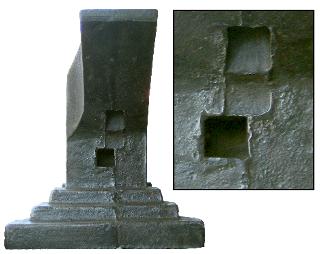This is one of the finest examples of a cast anvil in a traditional Austrian style.
An important feature is the location of the hardy hole which is immiately parallel to the side of the body of the anvil.
This gives it the most possible support while still open at the bottom.


SALGÓTARJÁNI ACÉLÁRUGYÁR RT.
3100 Salgótarján, Borbély L. út 2.
HUNGARY
SAC was established in 1868 and has a long history.
Today the company manufactures wire, nails, screen, bar and plate steel.
They no longer make anvils based on their web site. Anvil in Hungarian is üllö.
- Model: MNOSz1300
- Dimensions:
- Height 11-3/4" x Width 3-5/8" x Length 23" (300 x 92 x 584 mm)
- Base: Width 10-1/2" x Length 12-3/4" (267 x 324 mm)
- Weight: 75kg (168 pounds scaled weight)

At right you can see the break through of the hardy hole and the handling hole.
The ridges between are where the core print (locator for the cores to make the holes) was replaced by the core.
On this casting a single T shaped core makes the hardy hole and handling hole.

For simplicity the drawing above does not have the offsets of the featured anvil.
The core is made in a mold box seperate from the anvil pattern.
Cores are made of a resin bonded or baked sand and then coated with a graphite material to make them stronger and smoother.





Casting Details
At right you can see the break through of the hardy hole and the handling hole. The ridges between are where the core print (locator for the cores to make the holes) was replaced by the core. On this casting a single T shaped core makes the hardy hole and handling hole.